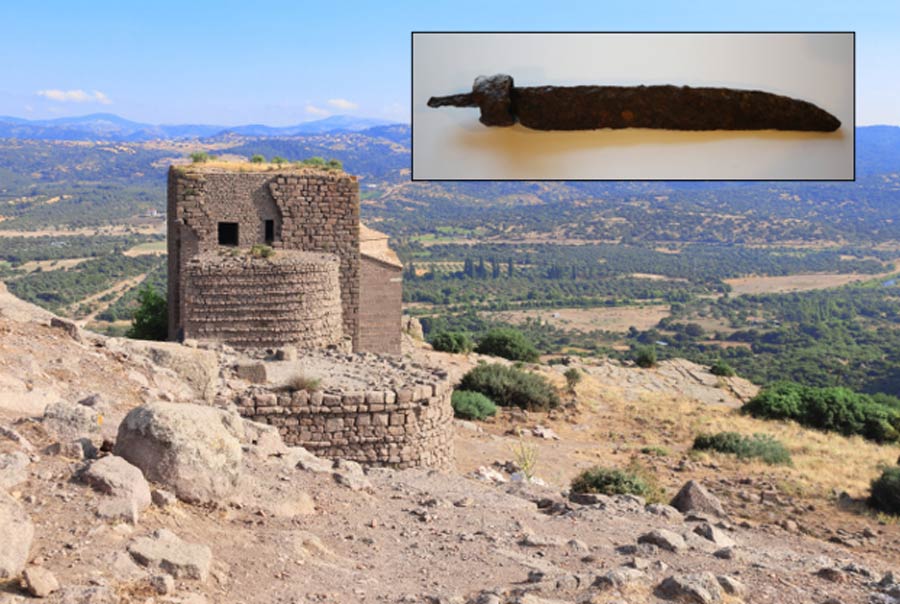1,300-Year-Old Machete and Ax Unearthed In Ruins of Assos, Turkey
Assos is a seriously pillaged and neglected ancient metropolis in Turkey. Many of the city’s greatest treasures today adorn European museums. Thus, the discovery of two ancient metal blades has made the headlines.
Assos, also known as Behramkale, is a small town in the Ayvacık district of the Çanakkale Province, Turkey. Situated among hundreds of ancient ruins this Aegean-coastal seaside resort was founded from 1000 to 900 BC by Aeolian colonists from Lesbos. Around 530 BC the settlers built the famous Doric Temple dedicated to the goddess Athena on top of the crag.
This year Turkish archaeologists have been carrying out excavations in the ancient city. Now, researchers have announced that “a machete and an ax” have been unearthed among domestic artifacts in Assos, dating to about 1,300-years ago, Daily Sabah reports.
Unearthing an Antique Kitchen
The recent Assos excavations are being led by Professor Nurettin Arslan of Çanakkale Onsekiz Mart University's Faculty of Science and Letters Department of Archeology. Arslan told Anadolu Agency (AA) that his team of excavators were digging into the foundations of dwellings dating to the Byzantine period. They discovered many fragmented clay pots and pans, and cooking utensils, and even a terracotta grill. Together, these artifacts help to illustrate day to day life at the settlement.
Arslan told Hurryiet Daily News that grilling is one of "the easiest methods of cooking meat.” Furthermore, the archaeologist also reported discovering specific pots that were used to boil grains, including chickpeas and lentils, on the stove. Besides food preparing pots and equipment the archaeologists also identified food and drink serving pans and food preservation pots. In conclusion, Arslan said this “large series of pottery from the Byzantine period, helps us determine the period of other pottery we found in the city.”

Byzantine-era cooking equipment unearthed in Assos. Source: Hurriyet Daily News
The Two Bespoke Metallic Blades
Besides hundreds of fragments of baked clay pottery, the archaeologists also discovered two sharpened metallic tools. The first item is described as “a large iron knife, which we believe is a machete.” This artefact was unearthed among a group fo Byzantine structures known as “the gymnasium,” which was a training ground for athletes. The second blade is believed to have been used specifically for “shaping and chopping wood.”
Having been hidden beneath the soil for 1,300 years the two metal blades are described as being in “quite good” condition. Arslan says these two pieces, above all the others, “constitute an important example for the materials used in production in Assos.”
Newly discovered iron machete, ax dating back 1,300 years provide information about lifestyle of people in ancient city of Assoshttps://t.co/nmoAV2YGMy
— DAILY SABAH (@DailySabah) September 10, 2021
Rediscovering Lost History
According to Christian tradition, between 53-57 AD, St. Paul visited Assos on his way to island of Lesbos during his third missionary through Asia Minor. Therefore, the archaeology of this site has always been in the sights of procurement managers at museums in major European cities. Between 1881 to 1883, the Archaeological Institute of America conducted the first digs at Assos. Then, in the early 1900s, an attempt was made to move “all” of the contents of Assos’ Temple of Athena to Paris. While this didn’t happen in totality, many of the best mosaics from the temple depicting mythical creatures and heraldic symbols are now featured at the Louvre, and in other museums.
Visitors to Assos today find a range of crumbling, neglected and vandalized monuments. An article in Archaeology.org says this results from “hasty excavation, long neglect, and bad reconstruction practices.” For these reasons, the discovery of a homestead where pots and cooking utensils were found still in situ, really is pure “cultural” gold. While two metal blades and some fragmented pottery is of little interest to the Louvre, because there are no royal associations, the discovery represents “archaeology of the masses” - evidence of how the 99.99% of people in history, who prepared their own foods, lived day to day.
Top image: Main: Ruins of an old fortress tower in Assos. Source: frenta / Adobe Stock. Inset: The machete blade found in Assos excavations. Credit: AA (via Daily Sabah)
By Ashley Cowie.



















